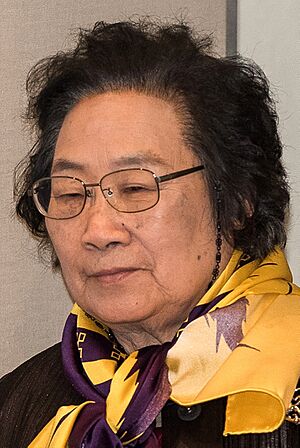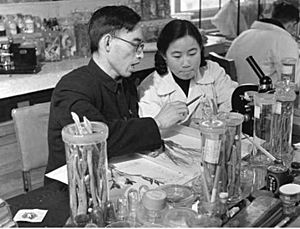Tu Youyou facts for kids
Quick facts for kids
Tu Youyou
|
|||||||||||||||
|---|---|---|---|---|---|---|---|---|---|---|---|---|---|---|---|
| 屠呦呦 | |||||||||||||||

Tu in 2015
|
|||||||||||||||
| Born | 30 December 1930 Ningbo, Zhejiang, China
|
||||||||||||||
| Alma mater | Beijing Medical College (BMed) | ||||||||||||||
| Known for | Discovering artemisinin and dihydroartemisinin | ||||||||||||||
| Awards | Lasker-DeBakey Clinical Medical Research Award (2011) Warren Alpert Foundation Prize (2015) Nobel Prize in Physiology or Medicine (2015) Highest Science and Technology Award, China (2016) Medal of the Republic, China (2019) |
||||||||||||||
| Scientific career | |||||||||||||||
| Fields | Medicinal chemistry Chinese herbology Antimalarial medication Clinical research |
||||||||||||||
| Institutions | China Academy of Traditional Chinese Medicine | ||||||||||||||
| Academic advisors | Lou Zhicen | ||||||||||||||
| Chinese name | |||||||||||||||
| Chinese | 屠呦呦 | ||||||||||||||
|
|||||||||||||||
Tu Youyou (Chinese: 屠呦呦; pinyin: Tú Yōuyōu; born 30 December 1930) is a famous Chinese scientist. She won the Nobel Prize in Physiology or Medicine for her amazing work. She discovered two important medicines, artemisinin and dihydroartemisinin. These medicines are used to treat malaria, a serious disease spread by mosquitoes. Her discoveries have saved millions of lives around the world.
Tu Youyou received the 2011 Lasker Award. In 2015, she shared the Nobel Prize in Physiology or Medicine with two other scientists. She was the first Chinese person to win a Nobel Prize in medicine. She was also the first woman from the People's Republic of China to win a Nobel Prize in any field. Tu Youyou did all her studies and research in China. In 2019, she received China's highest honor, the Medal of the Republic.
Contents
Early Life and Inspiration
Tu Youyou was born in Ningbo, Zhejiang, China, on December 30, 1930. Her father gave her the name Youyou. It comes from an old Chinese poem about deer eating a plant called Hao. This plant later became very important in her research.
She went to Xiaoshi Middle School and Ningbo Middle School. A serious illness called tuberculosis made her stop school for a while. This experience inspired her to become a medical researcher. From 1951 to 1955, she studied at Beijing Medical College. She learned about pharmacy and Chinese herbal medicine. After graduating, she worked at the China Academy of Traditional Chinese Medical Sciences. She also trained in traditional Chinese medicine for two and a half years.
Discovering Malaria Treatments
Tu Youyou continued her important research in the 1960s and 1970s.
The Fight Against Malaria
Malaria was a huge problem in many parts of the world. It caused many deaths, especially in China's southern areas. In 1967, a special secret project began in China. It was called Project 523. The goal was to find a new medicine for malaria. This was because the usual medicines were not working anymore.
In 1969, Tu Youyou was chosen to lead a research group for Project 523. She even traveled to Hainan to study patients with malaria. Scientists around the world had already tested many chemicals. But they had not found a good solution. Tu Youyou had a new idea. She decided to look into traditional Chinese herbs.
She studied old Chinese medical books and visited traditional doctors. She collected hundreds of old recipes for treating fevers. Her team then tested extracts from many different herbs on mice.
The Power of Sweet Wormwood
One herb showed promise: sweet wormwood (Artemisia annua). It had been used for "intermittent fevers," a sign of malaria. Tu Youyou found an old text from 1,600 years ago. It described how to use this herb. The text said to soak the herb in cold water and drink the juice.
Tu Youyou realized something important. Boiling water might destroy the active part of the plant. So, she tried a new method. She used a low-temperature process with ether to extract the substance. This new method worked! Tests on animals showed it was very effective against malaria.
In 1972, Tu Youyou and her team got the pure substance. They named it qinghaosu, or artemisinin in English. This discovery was a huge breakthrough. It has saved millions of lives, especially in developing countries. Tu Youyou also studied the structure of artemisinin. In 1973, she accidentally created another important medicine, dihydroartemisinin.
Tu Youyou was so dedicated that she tested the new medicine on herself first. She wanted to make sure it was safe for people. After her own test, she led successful studies with human patients. Her work was first published without her name in 1977. Later, in 1981, she shared her findings with the World Health Organization.
Her incredible work on malaria led to her winning the Nobel Prize in Medicine in 2015.
Later Career and Recognition
Tu Youyou became a top researcher in 1980. This is like being a full professor. In 2001, she started advising students working on their doctorates. Today, she is the chief scientist at the China Academy of Chinese Medical Sciences.
For many years, Tu Youyou was not widely known. But her amazing discoveries eventually brought her worldwide fame. She is sometimes called the "Three-Without Scientist." This is because she did not have a postgraduate degree, did not study abroad, and was not part of China's national academies. Despite this, she became a leading figure in Chinese medical science. She is an inspiration to many.
Awards and Honors
Tu Youyou has received many important awards for her work:
- 1978: National Science Congress Prize, China
- 1979: National Inventor's Prize, China
- 2011: Lasker-DeBakey Clinical Medical Research Award
- 2015: Warren Alpert Foundation Prize (shared)
- 2015: Nobel Prize in Physiology or Medicine (shared)
- 2016: Highest Science and Technology Award, China
- 2019: Medal of the Republic, China
See also
 In Spanish: Tu Youyou para niños
In Spanish: Tu Youyou para niños
- Drug discovery
- Malaria
- Antimalarial medication
- Artemisinin
- Dihydroartemisinin
- Traditional Chinese medicine
- Timeline of women in science


